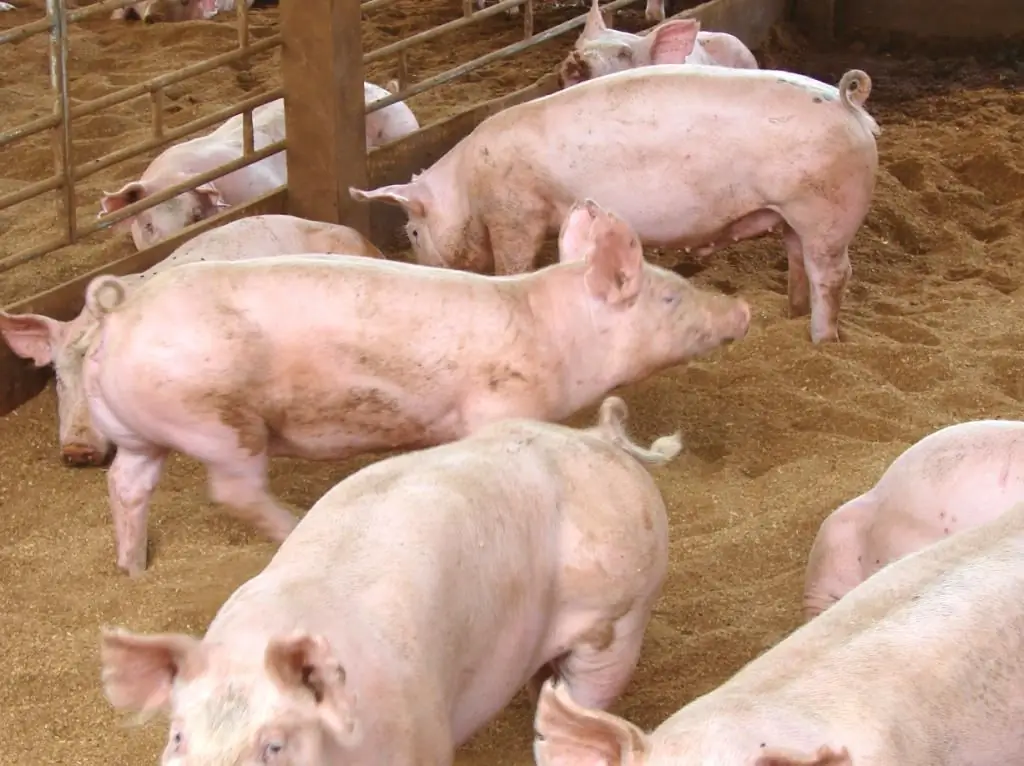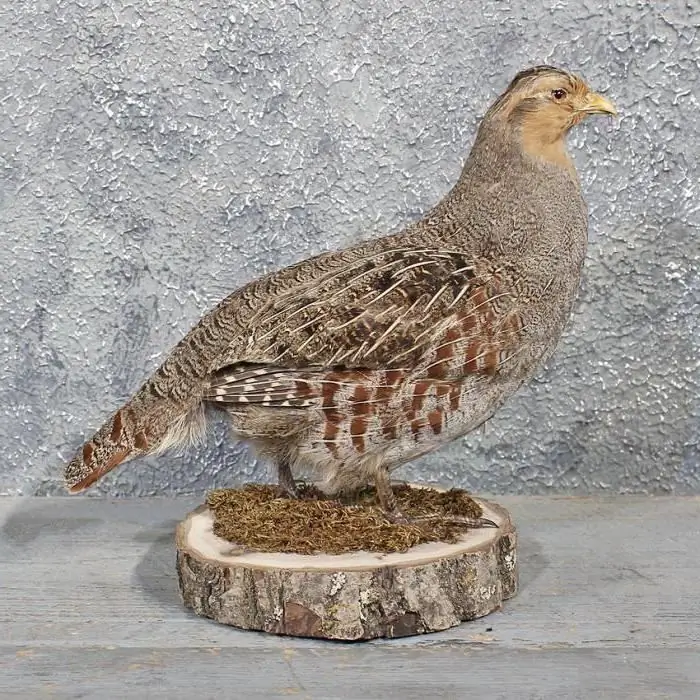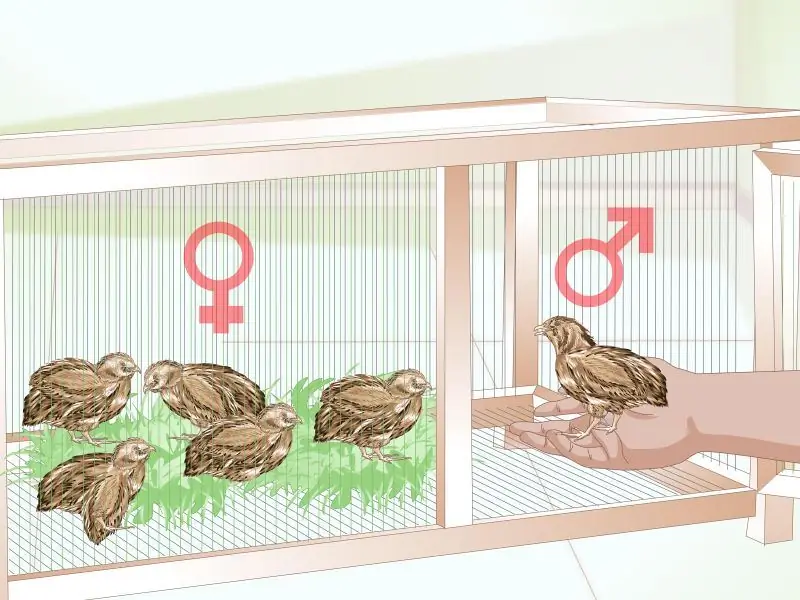2025 Author: Howard Calhoun | [email protected]. Last modified: 2025-01-24 13:10:25
Quail breeding at home is a cost-effective business that is available to almost everyone. It does not require large capital investments at the initial stages and is very promising. First, you should learn as much as possible about this bird, as well as where to start breeding quails.

Breed selection
At home, quails of the following breeds are bred:
- Japanese. The body of the Japanese breed is slightly elongated, with a short tail. Females and males have some color differences: the former have gray feathers on the chest, while the males have brown feathers. The live weight of the bird is small, about one hundred and thirty grams. Females begin laying eggs at the age of fifty days. For a year, a bird is able to bring up to three hundred eggs, each weighing about eleven grams. The Japanese breed is easy to care for, practically disease free and capable of producing eggs all year round.
- Manchu gold. This is an egg breed that has an unusual golden color. Live weightfemales reaches one hundred and seventy grams, and males are slightly smaller.
- Estonian. When crossing the pharaohs and the Japanese breed, Estonians were obtained. They are characterized by a rounded body shape with a slight arch of the back. In terms of productivity, Estonians are classified as meat and egg type. The egg production of females reaches 280 pcs. The bird begins to lay eggs at the age of forty days. This breed is considered the most unpretentious, as it is characterized by a high safety of quail after hatching.
- English. For quail breeding, this breed is considered one of the most promising. The bird is characterized by a white color, some feathers can be black. The female begins to lay eggs at the age of forty days. The weight of an adult individual reaches two hundred grams. During the year, the female lays about 280 eggs weighing 11 grams.
- English black. Feather color can range from brown to black. In terms of productivity, black Brits are the same as whites, and they are larger in weight.
- Tuxedo. The color of the bird is dark brown, with a white breast. The breed is obtained by crossing white and black British. Females start laying eggs at the age of six weeks. The weight of the bird is 180 grams.
- Pharaoh. This is the most popular meat breed. By the fifth week of life, the bird is gaining weight 150 grams. The bird begins to lay eggs only after the eighth week of life. This breed is demanding on the conditions of detention, so it is not suitable for everyone. During the year, the female carries up to 220 eggs weighing 11 grams each. The weight of an adult is 300 grams.
Before you start breeding quails at home, you shouldchoose a breed. It is best to try with two or three breeds that do not require special care and gradually move on to others.

Preparing "at home" for the bird
For breeding quails at home, you need to take care of the cages in advance. They should be free and not hamper the movement of the bird. In a cage of one hundred square centimeters, about eighty birds can easily accommodate.
Each cage should be provided with drinkers, egg troughs, feeders, litter trays.
Cages for breeding quails can be stacked one on top of the other to save space. With this placement, the lower tier should be at least ten centimeters from the ground.
The height of the cages should be small so that the bird cannot harm itself with something: the quail is a shy bird that jumps at loud sounds, often they smash their heads against the net.
You will need a brooder to keep the chickens. It should be warm and closed. Inside there is a heating source, a thermometer, a lighting device.
In the winter season, the bird needs to be heated. To provide her with optimal conditions of detention, the cages are placed in a warm barn, in a garage or other place that can be heated. Usually, heating is required in cases where the birds are kept small and are not able to heat themselves on their own, as well as when rearing for eggs. If the place of detention is not heated, then when the temperature drops below fifteen degrees, the quail will stop laying eggs, they will startget cold.

Starting a bird
After preparing the place of keeping and choosing the breed, the question arises of how much quails cost for breeding. For a tribe, you should buy adult birds aged 30-50 days, no more. It is best to purchase thirty-day ones. After moving, they will need two weeks to adapt to the new conditions of detention, after which most breeds begin to lay eggs.
You should not buy old birds for breeding quails at home, as they do not rush well and are hard to adapt. Also, do not buy chicks, as the slightest violation of the rules of keeping them may die.
If there is no experience in growing quails, then only "teenagers" are worth buying. Other options are not suitable. If there is experience in breeding other birds, the same chickens, and it is planned to breed a bird only for a personal table, then you can buy hatching eggs.
When purchasing birds for business, you must immediately purchase at least three hundred heads. Moreover, for every four females of the breeding herd there should be one male. Usually at least fifty birds are used per tribe.
The prices for quails in different regions are different, on average in the country one individual will cost two hundred rubles, which is not very expensive. Hatching eggs cost from five rubles apiece.

Gender determination
Quail breeding for beginners involves knowing how to tell a male from a female. The most accurate and reliable way isexamination of the secretory glands.
To see the floor, you need to pick up the bird and turn it upside down. Then gently spread the feathers at the cloaca with your fingers and examine it. In females, the surface is dark pink, without a tubercle. Males have noticeable growths - tubercles. If you gently press on them, then a foamy liquid will appear from the cloaca.
Quail keeping
Successful breeding and maintenance of quail requires certain requirements. This bird is thermophilic, so an open aviary (except for the summer period), as well as unheated rooms, is not suitable for it. In order for quails to feel comfortable and stably lay eggs, it is necessary to provide the right conditions:
- Lighting and temperature. For birds, the optimum temperature is twenty degrees. In the place of detention there should be no drafts, sudden changes in temperature. Lighting should be at least fifteen hours with a brightness of 20 lux. If you lower this figure, then egg production drops. You should also maintain a certain level of humidity - at least 60%.
- Ventilation. Quails need fresh air. To ensure its inflow, it is necessary to mount a good ventilation system. Do not place bird cages near windows.
- Soundproofing. The room in which the bird is kept must have good sound insulation. From sharp, loud sounds, quails experience stress, stop laying eggs, jump up, smashing their heads against the ceiling of the cage, and may also start pecking at their neighbors.
If possible, it is better to provide a rooman area of about 20 sq.m, divided into four sections. The first will contain adults. The second section is for the young, the third is for the incubation of the eggs, and the fourth is where the food is stored and prepared.
Fence off zones with simple partitions made of plywood or other light, opaque materials.

Feeding the bird
Is quail breeding profitable or not as a business? This question can be answered in two ways. It is beneficial to keep a bird for those who do not buy food or buy it partially. But the bird doesn't eat much. One adult has about 35 grams of food. Quails are fed 2-3 times a day. If a person plans to keep a bird for personal use, then 10-20 heads are enough. In winter, they can be put on meat or transferred to the balcony, to the veranda.
Quails grow fast: in thirty days the bird gains enough weight to start laying. Bird feed consume about thirty-five grams, but they drink a lot of water. They should always have fresh, clean water. It is changed at least twice a day.
For normal growth and development, quails must be given:
- wheat, barley, corn, millet;
- cake, sunflower;
- shell, chalk;
- mineral supplements, vitamins.
Meat and bone or fish meal, milk powder must be added to the feed.
To save time, you can purchase ready-made compound feed PK-5, PK-6 for young and PK-1 or PK-2 for adults.
You need to feed the bird two or three times aday, at the same time. In the warm season, green herbs and vegetables are added to the feed, and in winter - onions, oats, sprouted millet.
When breeding quails for meat, fattening starts from the age of thirty days. To do this, the proportion of corn and feed fats is gradually increased in the diet. You can not allow a sharp change in diet so that the bird does not die. With such a monthly diet, the bird quickly gains up to two hundred grams of weight.
Quail breeding business
Having an understanding of the breeding and keeping of quails, you can draw up a business plan. It should reflect the following data:
- Cost of quails.
- Incubator.
- Cells.
- Feed, supplements, vitamins.
- Electricity consumption.
- Transportation and other monthly expenses.
When calculating, it is necessary to take into account that not all birds will lay eggs: approximately 70% of the total population will not produce eggs. Poultry carcasses can also be sold, but it is better to do it on order.
Whether or not quail breeding is profitable as a business - everyone will have to decide for themselves. Usually in the first year, the bird does not provide income, but only returns the cost of maintaining, buying a tribe and equipment. And only from the second year of quail breeding profit begins.
The most difficult thing in poultry breeding is to find a market. Keeping hundreds of heads already requires selling an egg somewhere, not to mention a larger livestock. You can sell products in sanatoriums, medical institutions, shopping centers, restaurants, catering points, sell on the market, in barbecue houses, bars.

Incubation
A feature of quail breeding is the incubation of eggs. To do this, eggs are collected from the breeding herd, and then they are sorted. For incubation, only smooth eggs are selected without flaws, growths, dents, cracks. They should have the correct oval shape. The weight of the egg should be about eleven grams. You should not take too large and too small eggs, as nothing will hatch from them. For incubation, eggs are taken from a bird aged from two months, but not older than a year. The egg should not be more than ten days old.
To lay the incubator, it is not possible to collect the required number of high-quality eggs per day. Therefore, they are provided with proper storage at a temperature of ten to fifteen degrees. Eggs should not be kept at room temperature as this shortens the shelf life. When storing hatching eggs, 80% humidity is required.
When hatching chicks in the incubator, the temperature is maintained at 37.7 degrees, and from the thirteenth day to the fifteenth, it is lowered to 37.3-37.5 degrees. During withdrawal, the temperature is lowered to 37, 2.
Some farmers hatch birds at temperatures from 36.6 degrees to 37.0. Such indicators are not accidental, since everyone has different brands of incubators. To determine the temperature of your incubator, you need to conduct the first incubation and evaluate the percentage of brood, its he alth. Only by trial and error can you decide exactly what temperature should be, which places warm up well and which ones do not.
From the first day it is necessary to turn the eggs at least fouronce a day. In automatic devices, this is done by the device. Some poultry farmers do not turn the egg, but this is wrong. Chicks stick to one of the inner walls: the chance of such embryos surviving is zero.
If the incubator warms up unevenly, then you should change trays with eggs once a day.
With proper incubation, chicks will hatch on about the seventeenth day (different breeds have different incubation periods). Usually all chicks are born within nine hours. Babies are left in the incubator for several hours until completely dry, and only after that they are transferred to the brooder.

Other quail breeding methods
Some practice quail breeding on the balcony. This method allows you to keep a small number of birds. Usually in such conditions they keep up to five hundred heads, but if the balcony is large, then more is possible. The only downside is the smell. Quails emit a large amount of ammonia, nitrogen. You can cope with this smell if you clean the bird in the morning and evening.
You can start breeding quails in the country. Usually, when keeping a bird for themselves, with the onset of heat, summer residents buy about twenty heads of females and keep them in aviaries in the country. In autumn, the bird goes for meat. This method allows you to get a long period of home-made eggs, and then tasty, he althy meat. You can arrange a whole quail farm in the country, but this can only be done with year-round living near the bird: you can hire staff to take care of the farm.
Conclusion
Breeding quails is difficult only in the first year, because it is at this time that the poultry breeder begins to get to know the bird, learn its habits, preferences, and conditions of detention. Another difficulty to be faced is the marketing of finished products. Another disadvantage is the inability to go on vacation, as the bird requires daily attention: quails need to be fed, eggs collected, cages cleaned, trays washed, feed mixed, eggs incubated. Responsible and patient people are rewarded, the desire to profit from the farm bear fruit: in a year, with 700 heads, the farmer will be able to receive about $ 1,000 per month of profit (the figure is approximate and depends on the region).
Recommended:
Pig breeding at home - features, breeding and maintenance

How to start pig farming at home. What is the profitability of this business. How to equip pigsties. The right choice of breed and the acquisition of piglets. What to consider when writing a business plan. Pig diseases. Getting offspring
Ostrich breeding at home. Business plan for breeding ostriches

Ostrich breeding is quite profitable and not too troublesome business. The unpretentiousness of birds in care and the high cost of ostrich products are exactly the factors that can push the farmer to a new occupation for himself - breeding ostriches at home. How to start breeding ostriches? What needs to be done first? How much will it cost?
Partridges: breeding and keeping at home. Breeding and keeping partridges at home as a business

Breeding partridges at home as a business is a wonderful idea, because so far it is exotic to some extent, does not require significant investments at the start (or even none at all), there is no special knowledge for growing an unpretentious and little sick bird need. And demand today exceeds supply. This business can be especially interesting in small towns and villages where there are problems with employment and other types of earnings
How to grow quails at home from scratch: detailed instructions and tips for beginners

Quails are an excellent source of dietary eggs and delicious meat. The diminutive size of birds can scare away many breeders, but experienced poultry farmers know that these birds make a very good profit. Decided to start growing quails at home, but don't know how to properly care for these little birds? In our article you will find detailed instructions for beginner farmers, as well as a lot of other useful information regarding quail breeding
Caring for quails at home: keeping, breeding and feeding rules for birds

With the observance of technology, even in a small farm, it is possible to keep up to 50 heads in a cage measuring only one square meter without any problems. This is more than enough not only to provide your family with high-quality meat and eggs, but also to make good money selling them. But in order for quail care to be as simple as possible, it is necessary to consider a number of criteria

